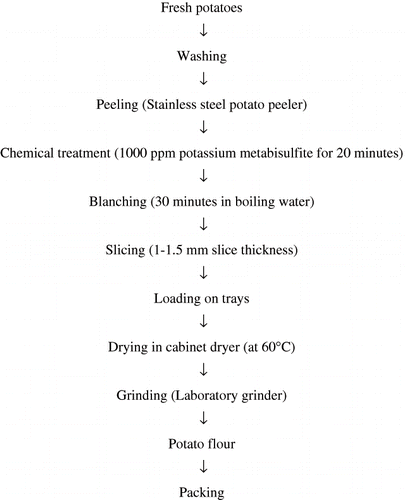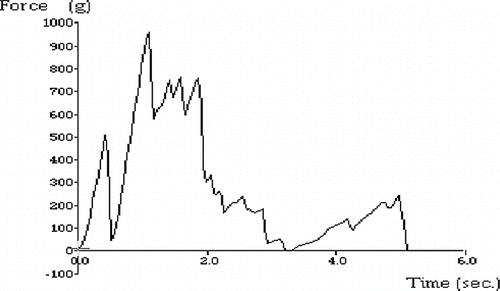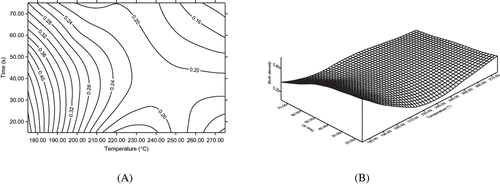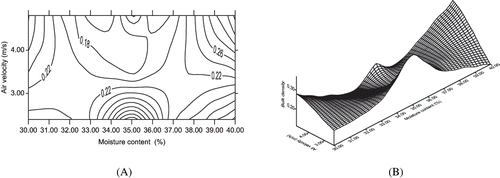Abstract
The effects of process parameters for high temperature short time (HTST) air puffing viz. puffing temperature (175–275°C), puffing time (15–75s), moisture content (30–40%), and air velocity (2.4–4.8m/s) on quality attributes such as expansion ratio (ER), bulk density (BD), colour (L-value), and texture (hardness) of ready-to-eat (RTE) potato snacks were investigated, based on central composite design. Increasing puffing temperature resulted in potato snack with a higher ER, lower hardness, lower BD, and lower L-value. Increasing puffing time produced lower hardness and lower L-value but no significant effect on the ER and BD. Higher moisture content increased ER and L-value but reduced hardness and no significant effect on the BD. Increasing air velocity resulted in potato snack with a higher ER, higher L-value, lower BD and lower hardness.
INTRODUCTION
In India, several ready-to-eat (RTE) products from potato are available in the market, such as potato chips, French fries, and soon. Additionally, there are several instant products, namely, potato granules, potato powder, and quick-cooking potato cubes. The potato chips are very popular snack food in India. The French fries are gaining popularity in big cities of the country, but these products contain higher amount of fat, which is harmful for human health. The oil contents in chips are 36.8% to 38.1%.[Citation1] High costs are also a reason that these products have not gained popularity and wide acceptance in India.
The RTE foods are prepared by extrusion cooking,[Citation2,Citation3] puffing, popping, flaking, frying,[Citation4] roasting, and soon. RTE food products include extruded snacks, puffed cereals, popcorns, rice flakes, fried fryums, potato chips, french fries, home made products like papads, kurdai, chakali, and more, which may be consumed after frying or roasting. The preferred grains for puffing are rice, wheat, oats or pearl barley, which are prepared by cleaning, conditioning and depericarping (e.g., by a wet scouring process). Flavouring adjuncts (sugar, malt syrup, salt, etc.) are added to the flaked products.[Citation5] The puffed products mainly prepared from cereals, are extremely popular as ready-to-eat snack food items because of their low costs and crisp textures. Puffing ideally creates an aerated, porous, snack-like texture with the added benefits of dehydration. Blending the puffed products with different flavours and marketing them in moisture impermeable plastic film pouches provides enormous opportunities for increasing acceptance and usage of puffed products.[Citation6]
Puffing of cereals results from the sudden expansion of moisture present in the interstices of the starch granules during the high-temperature-short-time (HTST) heating of the grains.[Citation7] The puffing process can be broadly classified as atmospheric pressure process with sudden application of heat and pressure drop process.[Citation8] The sand puffing, air puffing, oil puffing, and roller puffing are examples of atmospheric pressure processes,[Citation7] while gun puffing is the example of pressure drop process.[Citation9] The key to the degree of puffing of the cooked grain is the suddenness of change in temperature or pressure.[Citation9]
Chandrashekhar and Chattopadhyay[Citation10] studied 12 Indian rice varieties for varietal effect on puffing and found that the varieties Palmoi, Panloi, Kaviraj sal, Mugai, Bashkata, Masuri, Kakhura, Patnai, Lata sal, and Bhutia (Black) showed ER from 9.71 to 7.17 with decreasing order while variety Maul and Bhutia (white) showed ER of 5.34 and 4.82, respectively. Chandrashekhar[Citation7] found that for air temperature below 200°C, puffed rice produced was of very inferior expansion and above 270°C the puffed rice obtained was significantly discoloured.
Expansion of starchy vegetables, like potato, leading to a porous structure was also achieved by High Temperature Short Time (HTST) fluidized bed drying.[Citation11–14] They suggested that HTST pneumatic drying, when applied to a variety of vegetables, brought about porous structure in the products which resulted in considerable reduction in drying and dehydration time with improvement in texture of the cooked products. Hanson[Citation13] reported that when potato pieces were blanched with a suitable concentration of common salt and dried in fluidized state in a temperature range between 154 to 199°C for 5 to 20 minutes to a moisture level less than 10%, a product with porous structure was formed which had better rehydration properties. Varnalis et al.[Citation15] concluded that potato cubes blanched for 2 minutes in water at 100°C followed by drying in air at 90°C for 40 minutes resulted in the maximum increase in volume of puffed cubes. The optimized puffing conditions of potato cubes were, blanching for 6 minutes in water at 100°C, dipping in 400ppm sodium metabisulfite solution for 10 minutes, initially drying for 40 minutes and puffing in air at 200°C for 40 seconds, followed by final drying to a moisture content of 0.05 db using response surface methodology was reported by Varnalis et al.[Citation16]
Ready-to-eat dehydrated puffed potato cubes with a long shelf life was developed with high temperature short time (HTST) whirling bed treatment using CCRD, the optimum puffed product qualities in terms of volume expansion (2.6 times), toughness, colour, and ascorbic acid loss were obtained at an air temperature of 210°C, air velocity 3.76m/s and retention time of 80s.[Citation17] Considering the present need, development of potato based ready to eat puffed product may be considered as a snack food with great potential for consumer acceptability in India. This could be an excellent substitute to the French fries, potato chips and also other cereal based snack products. Considering the Previously mentioned points, the present investigation was aimed to study the effect of process parameters for high temperature short time (HTST) air puffing on quality of ready to eat potato snacks.
MATERIALS AND METHODS
Production of Potato Flour
The freshly harvested potatoes (Kufri chandramukhi) were procured from the market, washed, brushed and peeled. The eyes and all bruises were pitted out. Immediately after peeling, the potatoes were dipped in water containing a small amount of potassium metabisulfite (1%). The potatoes were boiled for 30 minutes in water. The boiled potatoes were sliced (1.0–1.5mm thickness) and uniformly layered in a tray and dried at a temperature of 60°C in a hot air cabinet drier for 4 to 5 hours.[Citation18] The dried and shredded potatoes were ground in a domestic grinder (Sumeet Brand) to pass through the sieve no. 72 (British Sieve Standards). The powdered potato flour was packed in air-tight containers ().
Pasta Preparation
The non-cooked pasta was prepared from potato flour by adding required amount of chilled water (5°C) and common salt. Kneading was done for 10–15 minutes to yield an uniform dough using Dolly Pasta Machine (Model-DOLLY, Automatic fresh pasta machine, The “La Monferrina” di A. Mascero & C. snc. Manufacturing company, Italy).
High-Temperature-Short-Time (HTST) Puffing
Puffing was done in a HTST fluidized bed air puffer specially designed and fabricated for the purpose. Pasta obtained were passed immediately through the HTST air puffer and thereby prepared RTE potato snacks (). A sample size of 100 g was selected for each HTST treatment. After the material was discharged from the HTST air puffer, the changes in expansion ratio, texture, colour and bulk densities were measured.
Expansion Ratio(ER) and Bulk Density (BD) Measurement
Expansion ratio and bulk density was measured using rape seed displacement method.[Citation19] For this the following expression was used:
Instrumental Texture Measurement
The texture characteristics of puffed RTE potato snacks in terms of hardness was measured using a Stable Micro System TA-XT2 texture analyzer (Texture Technologies Corp., UK) fitted with a 25 mm diameter aluminium cylindrical probe. Hardness value was considered as mean peak compression force and expressed in Newton (). Ten randomly collected samples of each snacks were measured and an average taken. The studies were conducted at a pre test speed of 1.0 mm/s, test speed of 0.5 mm/s, distance of 30% strain, and load cell of 5.0kg.[Citation20]
Color Measurement
The color (L-value) was measured using a simple digital imaging method.[Citation21] A high-resolution digital camera (2 mega-pixel or above) was used to measure color by capturing the color image of the sample under proper lighting. Once the color images of the samples were captured, the color was analyzed quantitatively using Photoshop.[Citation22] Photoshop can display L*value (L-value) in the Info Palette and Histogram Window.
Experimental Design
At first, the ranges of experimental parameters were selected based on preliminary trials for puffing temperature, puffing time, moisture content, and air velocity. The experimental design was applied after selection of the ranges. A central composite design was used to show interactions of puffing temperature, puffing time, moisture content, and air velocity on the quality of potato snacks in 30 runs, of which six were for the centre point, and twenty four were for non-centre point.[Citation23] The levels, codes and interval of variation of the independent variables are given in the , while the treatment combinations are presented in .
Table 1 Coded levels for the response surface design
Table 2 Treatment combinations for HTST puffing with 4 variable 2nd order design
A second order polynomial model for the dependent variables:
was established to fit the experimental data. An ANOVA test was carried out using Design Expert 6.0 (State-Ease Inc., Minneapolis, USA) to determine the significance at different levels (1%, and 5%).
RESULTS AND DISCUSSION
The coefficients of EquationEq. (2) () were obtained by fitting the response data in Design Expert by employing a procedure to find the best-fit model.
Table 3 Significant coefficients of regression Equationequation (1) Footnote a for the responses
Expansion Ratio
ER was highly significant (at 1% level) on linear terms of puffing temperature and air velocity and quadratic terms of puffing temperature, puffing time, moisture content, and air velocity, while ER was significant (at 5% level) on interaction terms of puffing temperature and puffing time. The positive coefficients of the first order terms of puffing temperature, puffing time, moisture content, and air velocity indicated that expansion ratio increased with increase of these variables while negative coefficients of their quadratic terms suggested that excessive increase of these variables resulted in decrease of ER. However, negative coefficient of interaction term (puffing temperature and puffing time) also resulted in decrease of ER (). Regression model explained 95.6% of the total variability in ER of the product. Reasonably good fit was obtained with coefficient of correlation (0.978), which showed that model developed was adequate for the experimental data ().
The effect of HTST air puffing conditions on potato snack ER were presented in the 3-D surface plot and contour plots ( and ). Increase in puffing temperature leads to a sharp increase of snack ER value at all time levels (). However, increase in moisture content and air velocity caused a slight decrease in the ER of snack and subsequently increased after certain limit ().
Figure 4 Contour plots (A) and response surface (B) for the effect of puffing temperature and puffing time on ER of RTE potato snack.
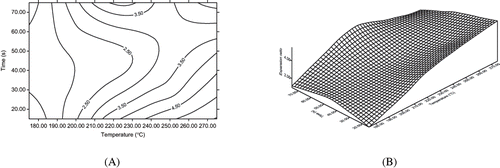
Figure 5 Contour plots (A) and response surface (B) for the effect of moisture content and air velocity on ER of RTE potato snack.
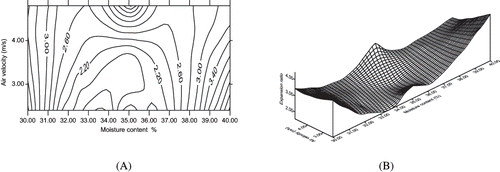
Mukherjee[Citation17] optimized ready-to eat dehydrated puffed potato cubes with long shelf life by high temperature short time (HTST) whirling bed treatment and he obtained volume expansion (2.605 times) at an air temperature of 210°C, retention time of 80s, initial moisture content of 40%, and air velocity 3.76 m/s. Similar effects of temperature and time on expansion of rice grains during high temperature fluidized bed puffing was also reported by Chandrashekhar and Chattopadhyay,[Citation24] while Roshdy et al.[Citation25] observed the same for puffing of corn. The effect of moisture content and air velocity in addition to temperature and time on expansion during rice puffing was reported by Chandrashekhar and Chattopadhyay.[Citation26]
Hardness
The snack hardness was highly significant (at 1% level) on linear terms of puffing temperature, puffing time, and moisture content and quadratic terms of puffing temperature and moisture content, while hardness was significant (at 5% level) on interaction terms of puffing temperature and puffing time. The negative coefficients of the first order terms indicated that hardness decreased with increase of these variables while positive coefficients of their quadratic terms suggested that excessive increase of these variables resulted in increase of hardness. However, positive coefficient of interaction term (puffing temperature and puffing time) also resulted in increase of hardness (). Regression model explained 91.6% of the total variability in hardness of the product. The experimental data for hardness of snack were found to fit adequately to second order polynomial model with a coefficient of correlation (R) of 0.957 ().
The effect of HTST air puffing conditions on potato snack hardness are shown in the 3-D surface plot and contour plot ( and ). Increase in puffing temperature leads to a decrease of hardness value of potato snack at all time levels (). However, increase in moisture content and air velocity caused decrease in the hardness of snack and subsequently increased after certain limit ().
Figure 6 Contour plots (A) and response surface (B) for the effect of puffing temperature and puffing time on hardness of RTE potato snack.
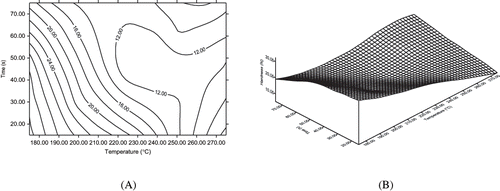
Figure 7 Contour plots (A) and response surface (B) for the effect of moisture content and air velocity on hardness of RTE potato snack.
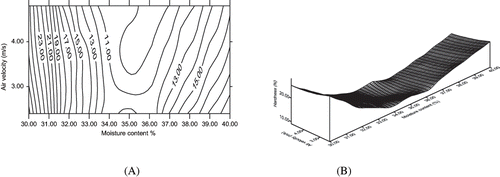
The effect of different combination of puffing temperature, puffing time, moisture content, and air velocity on toughness of ready-to-eat dehydrated puffed potato cubes was reported by Mukherjee.[Citation17] These observations are consistent with the present work. Chandrasekhar[Citation7] reported decrease in hardness with increase in expansion ratio in case of rice puffing which was again observed to be a function of temperature, time, moisture content and air velocity, and was in accordance with the present study.
Bulk Density
indicates that BD was significant (at 1% level) for puffing temperature and air velocity on linear terms, while significant (at 1% level) for puffing temperature, puffing time, and air velocity on quadratic terms. However, BD was significant (at 5% level) for puffing temperature with puffing time, moisture content and air velocity and also puffing time with moisture content on interaction terms. The negative coefficients of the first order terms indicated that BD decreased with increase of these variables while negative coefficients of their quadratic terms suggested that excessive increase of these variables resulted in decrease of BD. However, positive coefficient of interaction terms also resulted in increase of BD (). Regression model explained 94.5% of the total variability in BD of the product. Reasonably good fit was obtained with coefficient of correlation (0.972), which showed that model developed was adequate for the experimental data ().
The effect of HTST air puffing conditions on potato snack BD are shown in the and . Increase in puffing temperature leads to a sharp decrease of snack BD value, while increase in puffing time caused a slight decrease in the BD (). However, increase in moisture content caused a slight increase in the BD of snack and subsequently sharp decrease after certain limit, whereas, increase in air velocity caused a slight decrease in the BD of snack and subsequently sudden increased after certain limit with respect to increase in moisture content (). Similar effects of different combination of puffing temperature, puffing time, moisture content and air velocity on bulk density of ready-to eat dehydrated puffed potato cubes was reported by Mukherjee,[Citation17] while Mudahar et al.[Citation27] also observed the similar effect of temperature and time on bulk density of potato cubes, which was in agreement with the present findings.
Color
Changes in snack colour (L-value) during puffing were affected by puffing temperature (significant at 1% level) and puffing time (significant at 5% level) on linear terms, while air velocity (significant at 5% level) on quadratic term. However, interaction terms (puffing temperature with air velocity and moisture content with air velocity) were also found significant at 1% level (). The negative coefficients of the first order terms indicated that L-value decreased with increase of these variables while negative coefficients of their quadratic terms suggested that excessive increase of these variables resulted in decrease of L-value. However, negative coefficient of interaction terms also resulted in decrease of L-value (). Regression model explained 91.5% of the total variability in L-value of the product. The experimental data for L-value of snack were found to fit adequately to second order polynomial model with a coefficient of correlation (R) of 0.957 ().
The effect of HTST air puffing conditions on potato snack L-value are shown in the and . Increase in puffing temperature leads to increase in L-value of snack up to certain limit and there after decreases at all time levels (). However, increase in moisture content caused a slight increase in L-value of snack and subsequently sharp increase after certain limit with respect to air velocity (). This might be due to the fact that initially the surface colour intensity of the material decreased because of the volume expansion, but started darkening due to over exposure but no change occurred in the volume of the snacks. These observations are consistent with previous studies.[Citation17,Citation26,Citation28]
Figure 10 Contour plots (A) and response surface (B) for the effect of puffing temperature and puffing time on colour (L-value) of RTE potato snack.
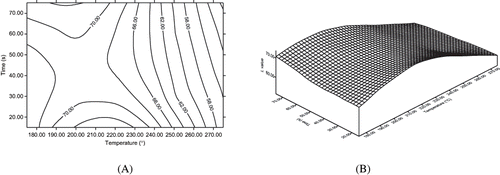
Figure 11 Contour plots (A) and response surface (B) for the effect of moisture content and air velocity on colour (L-value) of RTE potato snack.
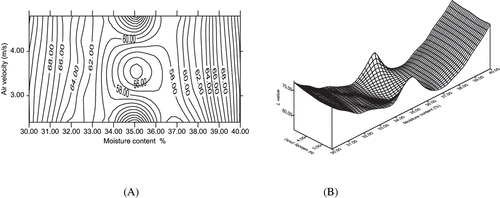
Effect of time on degree of brownness during dehydration of potato was reported by Mishkin et al.[Citation29] who observed that browning occurred only after a certain time exposure, which was more than 40 minutes with the drying air temperature of 80°C. These observations supported the present findings regarding the effects of the puffing process variables on the colour (L-value) of potato snack.
CONCLUSIONS
Expansion ratio, bulk density, colour, and texture of ready-to-eat potato snacks by high temperature short time air puffing process were dependent significantly on the process variables namely, puffing temperature, puffing time, moisture content, and air velocity. Puffing temperature had the greatest influence, whereas the effects of puffing time, moisture content, and air velocity were comparatively less on the quality attributes of potato snack.
REFERENCES
- Singh , S. , Raina , C.S. , Bawa , A.S and Saxena , D.C. 2004 . Sweet Potato-Based Pasta Product: Optimization of Ingredient Levels Using Response Surface Methodology . Int. J. of Food Sci. and Tech. , 39 ( 2 ) : 191 – 200 .
- Yu , J.Z. and Augustine , A. 2002 . Effect of Extrusion Cooking on the Properties and Acceptability of Bread-Crumb-Like Coating Products . Int. J. of Food Properties , 5 ( 3 ) : 573 – 584 .
- Gujral , H.S. and Singh , N. 2002 . Extrusion Behaviour and Product Characteristics of Brown and Milled Rice Grits . Int. J. of Food Properties , 5 ( 3 ) : 307 – 316 .
- Pedreschi , F. , Hernández , P. , Figueroa , C. and Moyano , P. 2005 . Modeling Water Loss During Frying of Potato Slices . Int. J. of Food Properties , 8 ( 2 ) : 289 – 299 .
- Kent , N.L. and Evers , A.D. 1994 . Technology of Cereals: An Introduction for Students of Food Science and Agriculture, , 4th , Oxford : Pergamon Press .
- Arya , S.S. 1992 . Convenience Foods-Emerging Scenario . Indian Food Industry , 11 ( 4 ) : 31 – 41 .
- Chandrashekhar , P.R. Some Studies on Heated Air Fluidized Bed Puffing Characteristics of Rice . Unpublished PhD thesis, PHTC, IIT . Kharagpur, (W.B.), India.
- Matz , S.A. 1970 . “ Chemistry and Technology of Cereals as Food and Feed ” . West Port, CT : AVI Publishing Co., Inc. .
- Hoseney , R.C. 1986 . “ Breakfast Cereals ” . In Principles of Cereal Science and Technology , Ch. 13 St. Paul, MN : American. Association. Cereal Chemists .
- Chandrasekhar , P.R and Chattopadhyay , P.K. 1991 . Rice Puffing in Relation to its Varietal Characteristics and Processing Conditions . J. of Food Process Eng. , 14 ( 4 ) : 261 – 277 .
- Gultterson , M. 1971 . Vegetable Processing , NJ : Noyes Data Corporation .
- Torry , M. 1974 . “ Dehydration of Fruits and Vegetables ” . In Food Technology Review , No. 13 NJ : Noyes Data Corporation .
- Hanson , L.P. 1975 . Commercial Processing of Vegetables , NJ : Noyes Data Corporation .
- Jayaraman , K.S. , Gopinath , V.K. , Pitchamuthu , P. and Vijayaraghavan , P.K. 1982 . The Preparation of Quick Cooking Dehydrated Vegetables by High Temperature Short Time Pneumatic Drying . J. of Food. Tech. , 17 : 19 – 26 .
- Varnalis , A.I. , Brennan , J.G. and MacDougall , D.B. 2001 . A Proposed Mechanism of High Temperature Puffing of Potato. Part II. Influence of Blanching and Initial Drying on the Permeability of the Partially Dried Layer to Water Vapour . J. of Food Eng. , 48 : 369 – 378 .
- Varnalis , A.I. , Brennan , J.G. , MacDougall , D.B. and Gilmour , S.G. 2004 . Optimization of High Temperature Puffing of Potato Cubes Using Response Surface Methodology . J. of Food Eng. , 61 : 153 – 163 .
- Mukherjee , S. Studies on HTST Whirling Bed Dehydration Technology for the Production of RTE Puffed Potato Cubes . Unpublished PhD thesis, Post Harvest Technology Centre, IIT . Kharagpur, (W.B.), India.
- Kulkarni , K.D , Kerure , Y.E and Kulkarni , D.N. 1988 . Evaluation of Potato Cultivars for Flour Production . Beverage and Food World , 8 : 214 – 221 .
- Segnini , S. , Pedreschi , F. and Dejmek , P. 2004 . Volume Measurement Method of Potato Chips . Int. J. of Food Properties , 7 ( 1 ) : 37 – 44 .
- Cruzycelis , L.P. , Rooney , L.W. and McDonough , C.M. 1996 . A Ready-to-Eat Breakfast Cereal from Food-Grade Sorghum . Cereal Chemistry , 73 ( 1 ) : 108 – 114 .
- Yam , Kit L. and Papadakis , Spyridon E. 2004 . A Simple Digital Imaging Method for Measuring and Analyzing Colour of Food Surfaces . J. of Food Eng. , 61 : 137 – 142 .
- Adobe Systems . 2002 . Adobe PhotoShop 7.0. User Guide , San Jose, CA : Adobe Systems Inc .
- Montgomery , D.C. 2001 . Design and Analysis of Experiments, , 5th , 455 – 492 . New York : John Wiley .
- Chandrasekhar , P.R. and Chattopadhyay , P.K. 1989 . Heat Transfer During Fluidized Bed Puffing of Rice Grains . J. Food Process Eng. , 11 : 147 – 159 .
- Roshdy , T.H. , Hayakawa , K. and Daun , H. 1984 . Time and Temperature Parameters on Corn Popping . J. Food Sci. , 49 : 1412 – 1414 .
- Chandrasekhar , P.R. and Chattopadhyay , P.K. 1990 . Studies on Microstructural Changes of Parboiled and Puffed Rice . J. Food Proc. Pres. , 14 ( 1 ) : 27 – 37 .
- Mudahar , G.S. , Toledo , R.T. and Jen , J.J. 1990 . A Response Surface Methodology Approach to Optimize Potato Dehydration Process . J. Food Proc. Pres. , 14 : 93 – 106 .
- Khodke , S.U. Freeze-Thaw-Dehydration Technology for the Production of Instant Potato Cubes . Unpublished PhD thesis, Post Harvest Technology Centre, Post Harvest Technology Centre, IIT . Kharagpur, (W.B.), India.
- Mishkin , M. , Saguy , I. and Karel , M. 1983 . Dynamic Optimization of Dehydration Process. Minimizing Browning in Dehydration of Potatoes . J. Food Sci. , 48 : 1617 – 21 .
